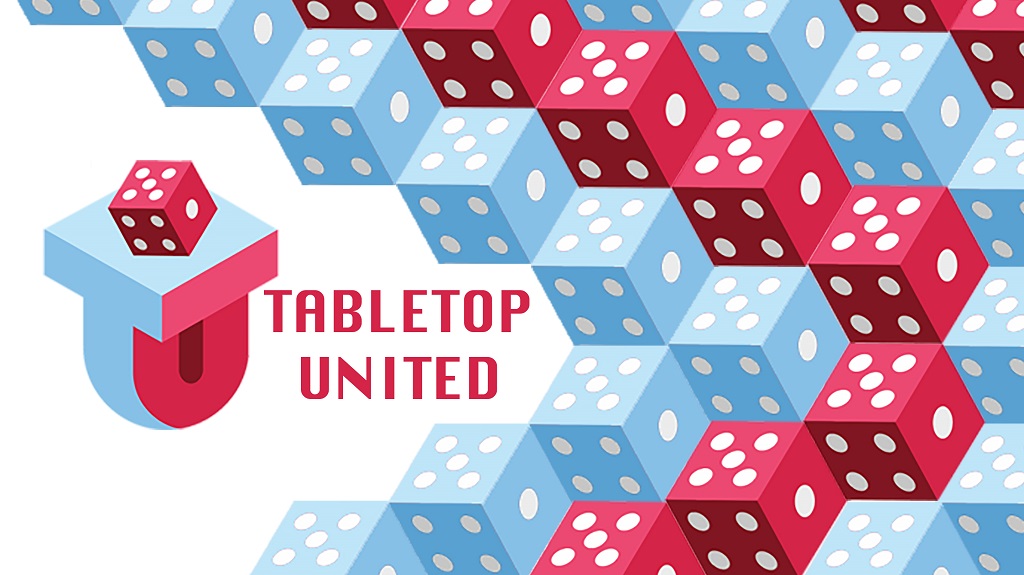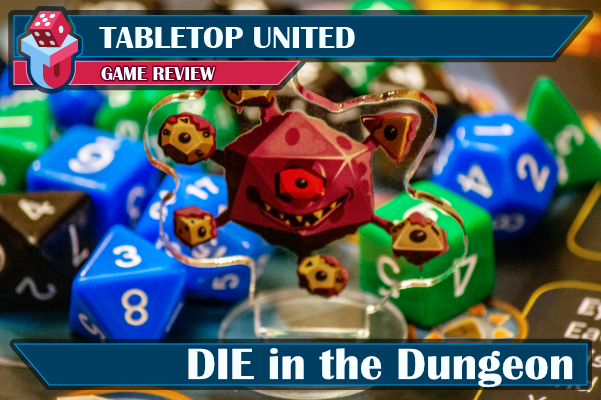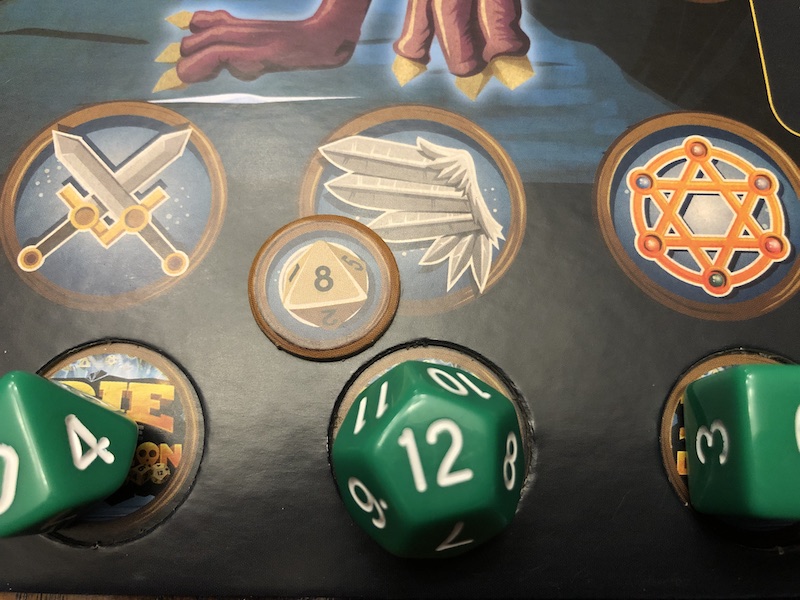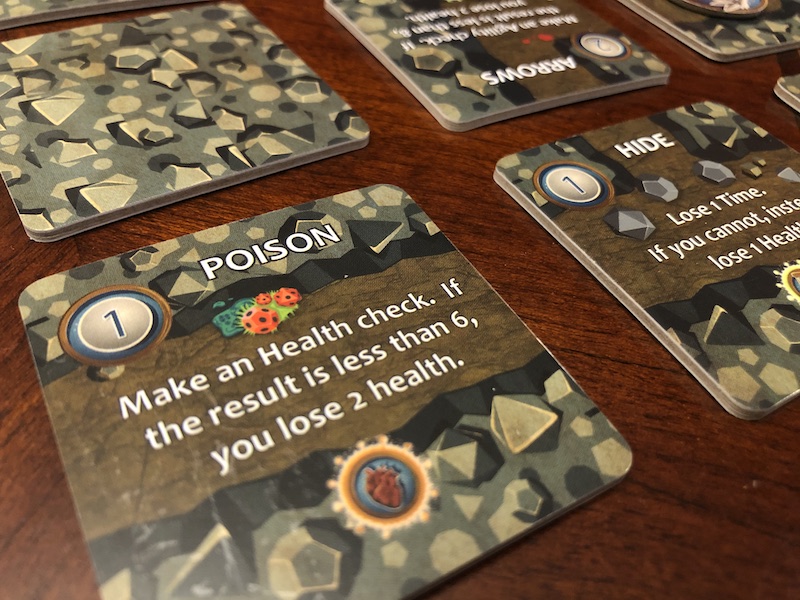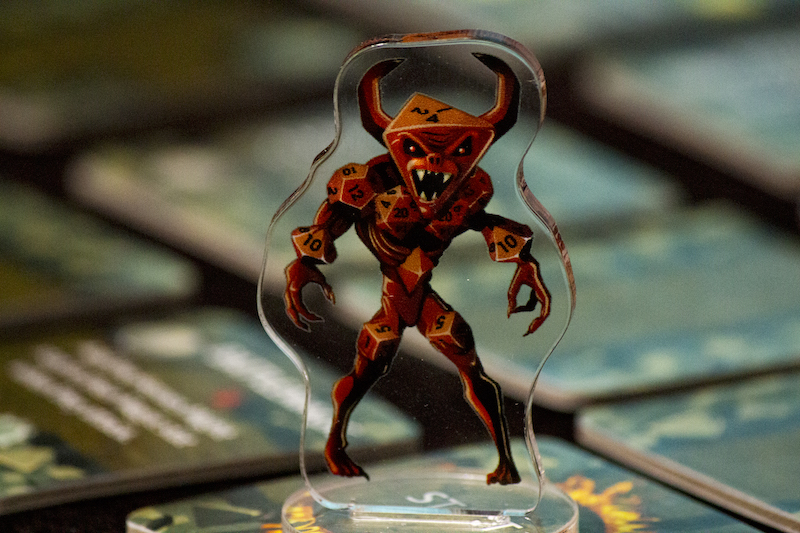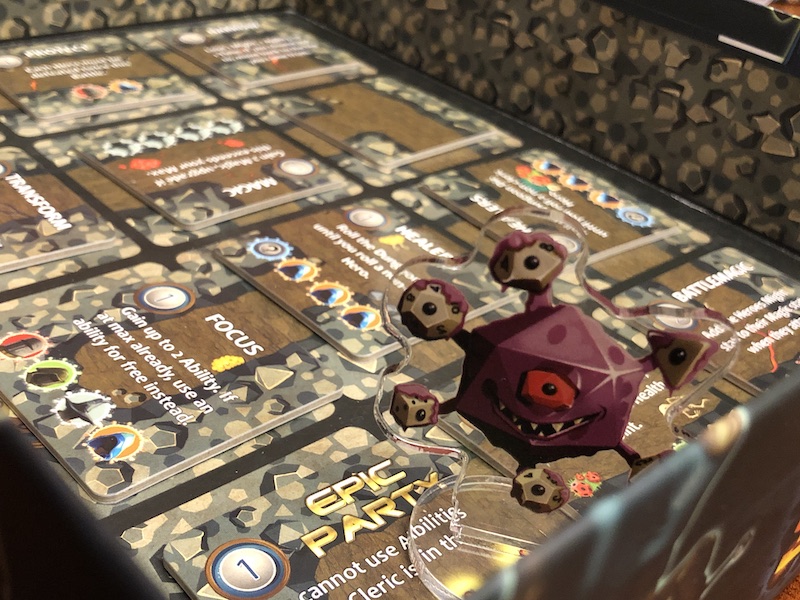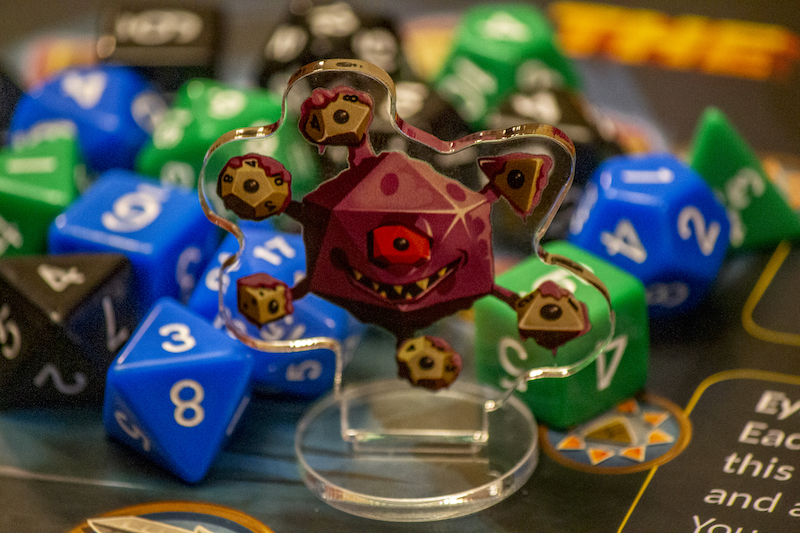DIE in the Dungeon Review
Designer: Wesley Woodbury
Artist: Tristam Rossin
Publisher: FunDaMental Games
Year Published: 2020
No. of Players: 1-2
Ages: 12+
Playing Time: 30-60 moinutes
Main mechanic / Theme: Dice rolling and manipulation / Fantasy
Die-ing in the dungeon has never been so much fun!
Find more info on BoardGameGeek.com
Overview:
DIE in the Dungeon! has you roaming the dank corridors and catacombs as a brutish monster, hunting heroes and epic parties to prove you’re worth your salt. There is exploration, combat and dice manipulation, and puns a-plenty.
While exploring dungeons as a wizard or rogue is a lot of fun, there’s just something special about doing it as the fiendish monster. Sure, you’re outnumbered pretty much every time you fight, but how else are you supposed to show off your prowess? The hero abilities make your life more difficult, but you have your own abilities they won’t be expecting.
I wasn’t worried about all the dice in the game, simply because I know that they’re practically a staple in many games with combat. However, the way the dice are used and manipulated is so much fun, and it doesn’t take long to figure out that your choices are what will make or break you, not the dice. Sure, yes, luck does come into play, but if you’re doing your job to manipulate and mitigate that luck, the game’s depth is deeper than you might expect on first glance.
I think one of the things that initially drew me to this game is the modular dungeon. The game comes with quite a few pre-constructed dungeons you can play in, but the possibility for more is endless. You can even amp up the difficulty of dungeons by adding more difficult heroes into the fray.
I’ve been fortunate to play DIE in the Dungeon many times already, and progressing through the various dungeons has been a lot of fun. Sure, I may have failed my first play through in the training dungeon (don’t judge me), but I was still getting my bearings. As the dungeons escalate in difficulty, so must my decisions. While it may be possible to defeat a dungeon’s Epic Party without first going through and leveling up, it’s certainly not recommended. That’s like having Link face off against Calamity Ganon in Breath of the Wild from the get-go. Possible, but incredibly difficult and, let’s be real, far less enjoyable. Unless your goal is a speed run (and your dice are on your side), your best bet is to explore and upgrade.
I’ll be talking a bit about the components later on, but I do want to point out the character standees. I may not be a miniature fanatic, but I do love playing with them. These standees, however, are my new favorite thing. They’re crisp and clear, and unlike normal miniatures that come with games, these standees are colorized (meaning my inability to paint in minute detail is not a problem!).
Now that I’ve shared some of my thoughts on DIE in the Dungeon, I think it’s time we dive into the game itself. Come with me as we roll through the gameplay and discuss various aspects of the game. The tl;dr of it all, however, is that I really enjoy this game and have had a great time every time I’ve played it.
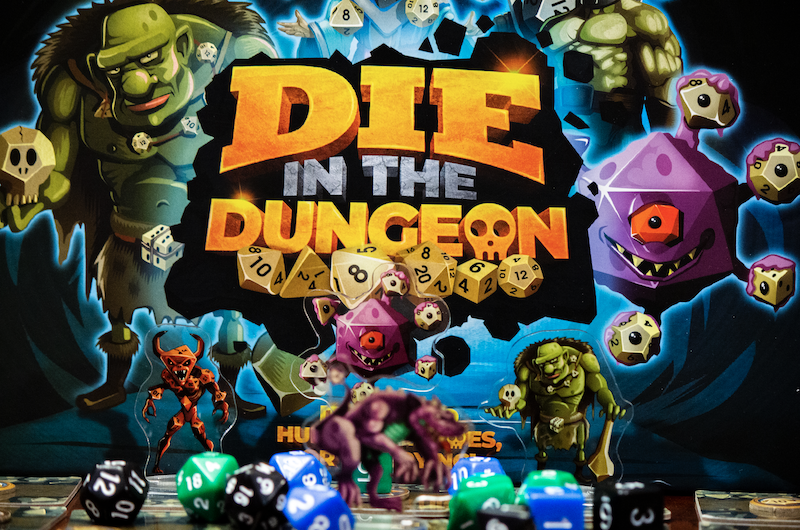
Gameplay and Mechanisms:
Each turn of the game is straight forward, and just in case your brain shuts off halfway through a turn, the handy turn order card will help keep you on track.
You win the game if you fulfill your dungeon’s requirement, usually requiring you to defeat at least one Epic Party. If your health reaches zero, you lose. If you run out of time on your Time die, you also lose. My advice to you is simple: Don’t lose.
At the start of each of your turns, you gain one Ability point (on your d4 on your monster board). Four is the maximum it goes, so don’t be afraid to use your abilities here and there, as those points will regenerate from turn to turn.
Next, you may rest. To do so, lose up to three Time points to regain an equal amount of Life points. If you’re on death’s door, this is a handy trick.
Moving is next. Basically, place your standee on a previously explored tile but next to one that hasn’t been explored yet.
Then you’re going to resolve tile effects. First, if there’s a token on it, take it. If it’s a DieMinion token, place it on your board. You can use these little dudes to roll extra dice during your battles. Very handy in a pinch. If there’s a Might, Agility, Magic, or Health token, take it. You may use it immediately to gain 2 points of that type of stat, or save it for later. If it’s a Time or Ability token, immediately gain 2 points of the corresponding stat (time or ability tokens cannot be saved for later use). After taking the tokens (if any), flip the tile to die-vulge any hidden instructions. Read and resolve the text on the tile. If there is an encounter (indicated by the heads of heroes you will be fighting), move to the encounter step. Otherwise, end your turn.
Encounters are where you fight those light-blighted heroes. You will fight one hero for each one represented on the tile, and those heroes will be at the level matching the tile level (upper-left corner). Simply collect those hero cards and place them in front of you. The heroes attack first (jerks).
Combat
Combat is fast, furious, and a little bit frightening at times. First, you are able to spend Ability points to use one of your special abilities. Spend your points on an Ability card then remove that card from the game, or use one of your reusable abilities found on your monster board.
After, hero abilities come the fight. Make sure you look at the back of another monster board for the hero chart to see if they have any special abilities to invoke before beginning the battle. They will also have bonuses for excellent rolls, so pay attention to those as well.
Each hero has a specific stat it attacks with, as indicated by the highlighted stat on its card (the cleric does not attack, but is just as die-abolical as the rest). To determine which die to roll for the hero’s attack, add up the entire team’s stats. Then roll the smallest die that could roll that. (i.e. If the team’s combined Might check for the Fighter’s Might attack is 11, then you would roll a d12 for the Fighter.) If the hero rolls higher than your matching stat die’s value, you take damage. If it’s equal to or less than your stat die’s value, nothing happens.
Note that when taking damage, you can choose to lose Health points or drop the value of your matching stat die by 1. (i.e. If you were to take damage from a Fighter, you could drop your Might stat die from 11 to 10.)
The Fighter is the first to come at you (all brawn, no brain). Combine his Might value with the Might values of the other heroes present, then roll the die. Then the Rogue comes in, swift as a coursing river (combine the team’s Agility stats), followed by the Wizard (combine all Magic stats). The Cleric just stands there, watching idly as his teammates rampage around you. Thanks for the help, dude.
Now it’s your turn to fight. Pick a stat and roll that die (using one of the extras not being used on your monster board). If the value is greater than the combined value of that same stat on the heroes’ team, defeat a hero of your choice. If a Cleric is in the fray, however, you must attack it first. Only after the team of heroes is Cleric-free can you begin attacking the other heroes. So the Cleric is useful after all. And annoying at that…
If your attack roll isn’t high enough, don’t worry—you have options. Use one of your DieMinions to roll a die of the matching value. If this still doesn’t reach your target number (stop rolling 1s!), you can throw in another DieMinion die. Alternately, you can reduce the value of your chosen stat die to increase your result by that many. So, if you rolled an 11 in Might and need a 13 to defeat a hero, you could reduce your Might stat die from 8 to 6, thus giving you the necessary 13 to defeat the villainous good guy. Remember, though, that reducing the values of your stat dice also makes it easier for the heroes to hit you. But, there’s always some give and take in battle, so follow your heart.
Each time you defeat a hero, increase the value of a Die-Namic Die by 1. When it’s at 6 pips, place it in the slot on the left of your board matching the value shown on the right of that slow (the first slot gives you one pip, the second gives two, etc.). Spend these pips to increase the value of your rolls.
Rinse and repeat until either all heroes are dead and gone, or you’re dead and gone.
You win the game if you complete your dungeon’s goal (i.e. defeating the Epic Party, including the associated Epic Hero). You lose if you die or run out of time.
Thoughts on Gameplay
The above may look like a lot but, really, it’s pretty straightforward. Although, I have been known to forget to reduce my Time die, so I recommend following the steps on the player aid cards while you’re learning to really ingrain the steps into your brain.
Yes, luck does play a roll role in the game. But it’s how the mitigation works that really makes the game a joy to play. I like the level of uncertainty the dice bring, but I also love that I’m able to turn a bad situation into a more desirable one (or, at least, less bad).
Everything about the gameplay fits right into the theme. From your monster roaming the dungeon to the parties of heroes hiding underneath tiles (don’t they get squished under there?) and to the puns all over the place, DIE in the Dungeon! is a superb solo experience. The dice chucking is fun and the mitigation allows for meaningful decisions. Of course, you can expect the unexpected, but for me, that’s half the fun!
Like a T-rex finally coming across an adjustable backscratcher, DIE in the Dungeon! scratches that itch of solo dungeon crawls in an accessible way. Die-hard gamers and newbies to the scene (welcome!) will both find this game a delight as well. Thank you, Wes, for bringing this game to life. The world is a better place because of it.
Theme, Artwork, and Mechanics
The fantasy/DnD theme of roaming dungeons and fighting bad guys has been flipped on its head, letting you control the “bad” guy. The mechanics play with the theme incredibly well, and while there are lots of dice involved, it still allows for some strategic (and quite possibly foolhardy, in my case) decisions.
The art is lovely (can you call monsters lovely?). Incorporating the dice theme into the art was a solid choice and really brings the monsters and heroes to life.
The components themselves are wonderful. The standees of the monsters are beautiful. They’re better than your generic cardboard standee that starts to show wear after the first use, and more colorful than your generic miniatures that come in various shades of grey. It’s a good hybrid that I’ve become a big fan of, thanks to these components. The acrylic used seems solid and durable, and snapping the characters in their stands/holders is easy to do while still maintaining their quality. These really do add to the overall ambiance of the theme and is much appreciated.
What Worked:
- Accessible solo game for all types of gamers
- Loads of dice
- Fun puns throughout
- Engaging gameplay
- Various methods of manipulating dice
- Great components/standees
- Multiplayer enabled
- Pre-built dungeons
- Build-your-own dungeons: new layouts are seemingly endless!
Final Thoughts:
I’ve said it once and I’ll say it again: This game is great. I’ve enjoyed playing it many times. I appreciate the chance the dice bring while also being able to take that chance and make it work how I want it to. The give-and-take in dice manipulation is a wonderful construct and it leaves you wondering how you’re ever going to get out of certain dicey situations. And, sometimes, you don’t. Sometimes, you just end up die-ing in the dungeon. When that happens, dust off your shorts, re-lace your sandals, and die-v (sorry, that one was stretching the limits a bit) back in to exact revenge on those die-spicable heroes!
Obviously, there is luck involved, as this is a dice game at its core. But you know what you like, so if that's your cup of tea, then DIE in the Dungeon may very well be a good choice for you Chances are, if you like solo gaming or just a good dungeon crawl, you’re going to want to check out DIE in the Dungeon. If you’re looking for an entry-level solo or dungeon crawler that still holds its weight with more seasoned gamers, look no further.
